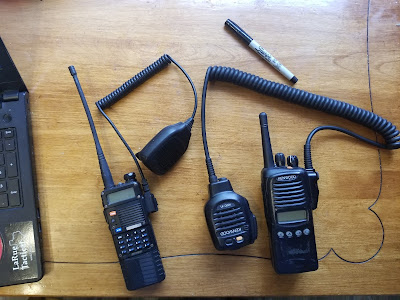While not planned out in advance, this post should make a nice follow-on to Part 1 of my Practical Rifle series. Earlier this week, I did a good deal of desert shooting with some friends. In contrast to my usual type of shooting, we were within 10-50 yards of our targets and focused on target transitions and combining movement with shooting. I consider this to be reasonable defensive range for encounters in open country, and multiple assailants are a possibility that should not be discounted. This is why I specified the capability for rapid followup shots in Part 1, as well as a maximum low-end scope magnification of 3x.
Beyond slow-fire shooting for accuracy at longer ranges (relevant for pest control and scout/sniper applications), I propose two types of drills for training with the practical rifle.
The first, focusing on multiple target engagements under physiological stress, should require the shooter to sprint a moderate distance, say, fifty yards, and then engage two or three targets at roughly 10-20 yards with two hits each. The sprint portion of this drill is simply to incorporate stress. An adrenaline rush is a typical reaction to any kind of defensive scenario, and simulating the accompanying loss of coordination/gross motor skills has undeniable training value. (Author's Note: The first time I had to use a firearm in a defensive manner, I had an adrenaline rush and briefly froze up. That seemed to have mentally conditioned me, and later instances have been smooth.)
The second drill is the snap shot, simulating a surprise encounter with a threat, human or animal. From the shooter's choice of carry/ready position, engage a man-size target at 25-50 yards. Any time under two seconds is acceptable. For variations, include a follow-up shot and/or increase the range as the shooter becomes comfortable with the drill. I've done snap shot drills with a pie plate hanging from a tree.
Do not hesitate to incorporate home or backyard dry-fire practice into your training regiment. Snap shots in particular can be practiced for free, as the focus is on a first-round hit at a range where wind calls and holdovers are irrelevant. Vary target presentation, sizes, range, and other factors - mastering a single target presentation is a neat party trick but its actual utility in the field is limited. Training merely approximates real-world conditions, rather than precisely simulating them.
To my mind, once the shooter has reached an acceptable level of skill with his practical rifle, the next step is to carry it in the field. Go for a hike on BLM or Forest Service land for at least a couple of hours, and get to learn the rifle's balance and carrying characteristics. Make changes as appropriate. Practice "snapping in" on boulders, shrubs, or other features - this plays into varying target presentation.
 |
| Get your rifle out in the field! |
Lastly, do not neglect the fundamentals of marksmanship. Shooting off a bench is useful for zeroing, load testing, confirming a computer-generated dope card, and training beginners, but does not even begin to simulate real-world conditions. Your fundamentals should be practiced from a variety of field positions. Likewise, it would behoove you to practice quickly dropping into supported field positions using available features. The other day, a good friend asked me what would qualify as field positions. My answer was something to the tune of "anything you can get into out in the desert with what you carry on your person". That's really all there is to it.
 |
| 100 yards with Federal Power-Shok 130-grain copper HP |
 |
| 275 yards with Federal Power-Shok 130-grain JSP |
Lastly, I decided to include a few groups shot with my 7600 practical rifle a couple of weeks ago, both zero confirmations. I'm using a 200-yard far zero with this rifle for its flatter trajectory over a 100-yard far zero, which theoretically results in 1.4" high at 100 yards, and a few inches low at 275 yards. Within shooter error and rifle accuracy limits, that's pretty much what I got. I would be more than comfortable taking a shot at a game animal to 300 yards. That group at 275 is a bit under MOA - there is no practical difference in accuracy between this pump rifle and most bolt guns. I suppose the platform could be called the poor man's M1A/M14, when equipped with a few reliable 10-round magazines.
The copper hollowpoints were an impulse purchase at Cabela's. I suspect they may be a bit more barrier-blind than Federal's garden-variety JSPs as a result of their monolithic construction, and my 7600 shoots them well with no significant POI shift. The barrier-blind theory merits testing, in my opinion.










